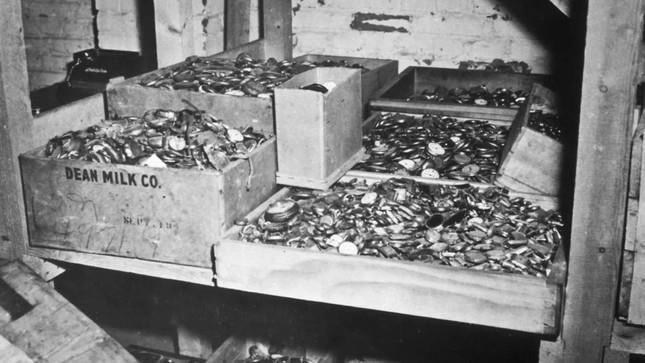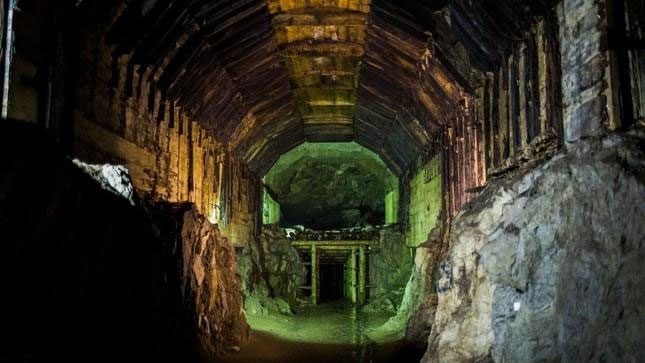When Nazi Germany occupied much of Europe and North Africa during World War II, gold, valuable artifacts, and priceless paintings vanished from the conquered territories, and many of these treasures remain missing to this day. Many believe that the Nazis hid these treasures in secret locations. Does the stolen gold from the Nazis truly exist?

Nazi gold coins discovered.
The answer is yes: Not only was Nazi gold real, but it also served as a motivation to fund Hitler’s regime. As Nazi forces spread across Europe, their policy was to plunder valuable items from victims, predominantly from Jewish individuals. This included artworks, jewelry, Oriental rugs, silverware, porcelain, and glassware. However, the most economically significant item was gold.
At least nine large boxes filled with gold coins and jewelry were collected by the Nazis from their victims. These items were found in a cave adjacent to the Buchenwald concentration camp.
Thousands of gold coins and jewelry collected by the Nazis were discovered by the U.S. Army in a cave near the Buchenwald concentration camp in May 1945 in Weimar, Germany. SS guards had stripped valuables from the corpses of their victims to salvage gold.
Nazi gold is a term encompassing both monetary gold, held by governments in central banks as part of their monetary reserves, and valuable items stolen from individuals (often not gold).

The mysterious underground city of Nazi Germany, Riese, is believed to be where the legendary Nazi gold train is hidden.
Ronald Zweig, a professor of Israeli studies at New York University and author of the book “The Gold Train: The Destruction of the Jews and the Looting of Hungary” (William Morrow, 2002), stated: “This is not something stolen from victims. We know that the Germans stole the monetary gold reserves of all the national banks of the countries they occupied, and only 70% of that gold was recovered after the war.”
Typically, the Nazis confiscated monetary gold and stored it in central depots, later using it to fund their war efforts. However, they also looted gold from individuals. “Non-monetary gold originated from the looting of homes, properties, and even the bodies of victims,” Zweig writes in his book. Much of what was seized from individuals was lost or confiscated by the end of the war.
In 1945, U.S. Army units unearthed hidden caches of loot across Germany and Austria. The most spectacular discovery was the Merkers salt mine in Thuringia, Germany, which contained gold bars, coins, and currency valued at $517 million in 1945 (approximately $8.5 billion today).
According to Zweig, as Allied forces took control of occupied territories, an effort was made to redistribute monetary gold to the nations from which it had been taken. Some trophies obtained from individual victims were auctioned to the public. However, other recovered treasures were sold, and the proceeds were given to organizations established to assist Jewish refugees post-war.
The total value of the gold and other assets looted by the Nazis remains uncertain. Initial reports of loot “created an El Dorado in Central Europe,” Zweig wrote in his book.
Many stories about Nazi gold have been recorded
Many believe that not all looted gold has been discovered. However, Ian Sayer, a British historian of World War II and co-author of the book “Nazi Gold: The Sensational Story of the World’s Greatest Robbery – and the Greatest Cover-Up” (Congdon & Weed, 1985), remains skeptical as such stories emerge in the media.
When the “Michaelis” diary—allegedly written by a Waffen-SS officer under the pseudonym “Michaelis“—was reported for the first time in 2020, it purportedly revealed 11 locations where the Nazis hid gold, jewelry, priceless paintings, and religious artifacts.
Another story about the location of the Wałbrzych gold train suggests it contained a stash of Nazi gold. The train is believed to be buried inside a mountain in southwestern Poland. When the location was extensively excavated in August 2016, no gold and no train were found.
Ronald Zweig’s book “The Gold Train” recounts a true gold train that left Budapest loaded with gold, silver, and jewelry stolen from Hungarian Jews. The train was headed toward a Nazi stronghold somewhere in the Alps. It stopped at Böckstein, Austria, hiding in the Tauern tunnel.
Some of the loot was taken and buried at various locations throughout Tyrol (a state in western Austria) and Feldkirch (a medieval town in western Austria), later discovered by local farmers and the French army after the war ended. The loot on the train was seized by U.S. armed forces in May 1945. However, some treasures have never been uncovered.
Nonetheless, the Tripartite Committee on Monetary Gold (TGC), established in 1946 to recover gold stolen by the Nazis and return it to its rightful owners, could not complete its work until all Nazi gold was recorded for restitution.
Prior to the London Conference on Nazi Gold that year, aimed at finalizing the work of the TGC, the Bank of England issued a new statement revealing the exact amount of gold the TGC was holding.





















































